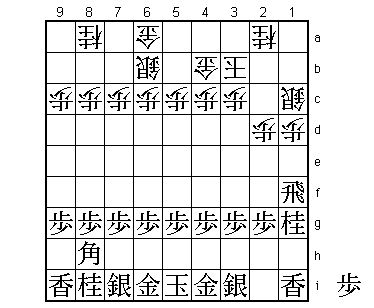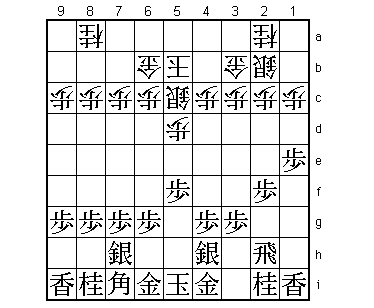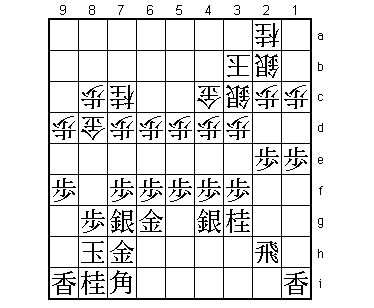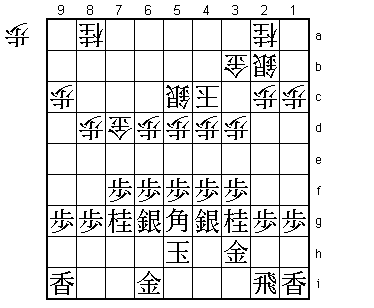

In this section we'll look at some alternatives to the climbing silver or gold. Some of these are pretty good, but in my opinion not as clear and easy as the climbing gold. They are however instructive, and it's interesting to see how white can make a fight against these dangerous attacks.
Second most often recommended attack at this handicap is the knight attack. It aims at a very quick knockout, before white can coordinate his forces. The main line runs like this : 1... S6b 2 P1f P5d (2... G7b, 2... G3b, or 2... K4b is probably better) 3 P1e S2b (3... G3b is probably better) 4 R1h S5c 5 P1d Px1d 6 Rx1d P*1c 7 R1f G3b 8 N1g (or 8 P9f G7b 9 P9e G8b 10 N1g, which is similar) P2d (else 9 N2e and 10 Nx1c+ wins rather easily) 9 P*1d! G2c 10 Px1c+ Gx1c 11 N2e! Px2e 12 R8f (This shows why P7f was omitted) G7b 13 Lx1c+ Sx1c 14 R1f P*1d 15 G*2c. Black has traded lance and knight for a gold, a slight loss, but his threats give him a big advantage. But there are some problems with this system. First of all, white can play 3... G3b, and if play follows the above line, 7... G2b will spoil the above plan. Perhaps better yet, white can omit ... P5d and ... S5c in favor of ... G7b and ... K4b, so that black has no double attack on move 12 in the above line. Finally, white can play Nada-style, for example 1... K4b 2 P1f K3b 3 P1e S2b 4 R1h S6b 5 P1d Px1d 6 Rx1d P*1c 7 R1f (7 R1h intending P3f and N3g is better) G4b 8 N1g P2d 9 P*1d Px1d 10 Rx1d S1c 11 R1f P*1d

After 11... P*1d
and white is okay because he can answer 12 P*1b by K2b or 12 P2f by K2c, with no easy win for black.
The knight attack can also be played with an early P7f. The main line runs 1... S6b 2 P7f P5d (normal, but I consider 2... G7b (Iida Hiroyuki) or 2... K4b (Nada Rensho) to be more accurate due to this variation) 3 P1f S5c 4 P1e S2b 5 R1h G3b 6 P1d Px1d 7 Rx1d P*1c 8 R1f K5b (to guard the 6c pawn. 8... K4b avoids the following line, but allows the same type of attack as in the above 2 P1f attack) 9 N1g P2d (else N2e and Nx1c+) 10 P2f G2c 11 P2e Px2e 12 Nx2e P1d (12... P2d 13 Nx1c+ is good for black) 13 P*1c! Nx1c 14 P*2d! Gx2d 15 Nx1c+ Sx1c 16 Bx3c+ with a huge advantage (Pieter Stouten (amateur) vs. Aono Teruichi (pro)). This is probably why Nada once said that after 2... P5d "Black can win easily". White can avoid all this if he omits ... P5d and ... S5c in favor of ... G7b (guarding 6c) and ... K4b (guarding 3c). Iida's setup, with an early ... G65b and ... S8b, also avoids this attack. Another defense is 2... G3b 3 P1f S2b 4 P1e P2d, but then the attack 5 P2f followed by S3h-2g-3f is quite strong.
If black likes the knight attack, I recommend that he take the extra three tempi to play P7f, P2f, P3f and N3g, instead of just N1g. This is quite decisive against the Nada line; I won very easily in my last game at four piece with Nada using this attack, which is not given in the literature. The main line would go like this : 1... K4b 2 P7f K3b 3 P2f S6b 4 P1f G4b 5 P1e S2b 6 P3f P5d 7 N3g S5c 8 R1h S4d 9 P1d Px1d 10 Rx1d P*1c 11 R1h P2d (else 12 N2e) 12 P*1d! Px1d 13 Rx1d S1c 14 R1h P*1d 15 P2e and white has no defense. Instead, I think white should switch to classical play against this plan, which means that he should keep the option of ... K3b or ... G3b until black reveals his plan. For example, 1... K4b 2 P7f S6b 3 P2f P5d 4 P1f (4 P2e K3b will transpose to the Nada system of Part I) S5c 5 P1e S2b 6 P3f P4d 7 N3g K4c (reserving 3b for the gold) 8 R1h P3d 9 P1d Px1d 10 Rx1d P*1c 11 R1h N3c (if 11... G3b 12 N2e is too strong) 12 P*1b G3b 13 P1a+ Sx1a 14 Rx1c+ S2b 15 +R1h P*1c Black has promoted his rook, but it is an "empty promotion", meaning that since he has been expelled from white's territory, it does not promise further dividends. It's still a nice profit, but not as convincing as the main line of the climbing gold. Black can aim to play P2e, +R2h, P*1b, and P1a+, though it feels a bit slow.
Hatakeyama Nariyuki 7 Dan Pro was more impressed by this system than by either the climbing silver or gold, and recommends it.
Another version of the knight attack, as given in a book by two of the all-time greats, Oyama Yasuharu and Nakahara Makoto, involves using the bishop to attack the 1c pawn. For example, 1... S6b 2 P2f G3b 3 P1f P5d 4 P1e S2b 5 P5f S5c 6 S4h K5b 7 S7h G6b 8 B7i

After 8.B7i
P7d 9 N1g P6d 10 N2e P2d 11 Nx1c+ Sx1c 12 P1d S2b 13 P2e! Px2e 14 P1c+ This is very good for black; white's only hope is that the advance of the pawn in front of black's king will give him some counterplay. However I think white should play 8... S4d 9 P3f (9 N1g P3d 10 N2e P3e) P3d 10 P2e (10 N3g P7d 11 N2e P3e 12 Px3e P2d is unclear) P7d 11 L1g P6d 12 R1h K6c 13 P1d Px1d 14 Lx1d P*1c 15 Lx1c+ Sx1c 16 Bx1c+ Nx1c 17 Rx1c+ Black has broken through and promoted his rook at the price of losing bishop for silver and pawn. This plan was suggested to me in private conversation by Oyama in response to my question of how to defeat Nada's line, and indeed it would lead to an easy win with white's king on 3b instead of the gold. In the given position, though, white's king is pretty safe and I would not call this a clear success for black.
With all these quick attacks running into problems, what about patient play, making a secure castle? Kato Hifumi 9 Dan once wrote that the fortress castle is a good choice for any handicap game, and it seems to make good sense at four piece since the bishop ends up pointing at the weakness on 1c. How would white make a fight of it then? Well, I tried a somewhat similar system against Nada in one game, and he set up the following defensive formation (shown here against the fortress) :

He just moved his gold back and forth from 4c to 4b, waiting for my attack but ready to launch a counterattack as soon as he got some pieces in hand. I won, but not without some complications. Aside from the difficulty of starting the attack, black has to be careful about his order of moves, as he might allow white to start a fight before his formation is completed.
I think that if black is going to play a slow system, it is better to adopt one that allows him to attack on either side. The most promising formation seems to be one that was mentioned by Kazuo Manabe 8 Dan for two piece handicap, but which looks really powerful at four piece. The following line is as given by him, with white's moves modified to be appropriate for four piece: 1... S6b 2 P7f P5d 3 S4h S5c 4 P5f P4d 5 P4f G3b 6 S4g K5b 7 S6h S2b 8 P6f P3d 9 P3f K4c 10 N3g G6b 11 S6g P7d 12 K5h P6d 13 R2i G7c 14 G3h G8d 15 B7i P7e 16 Px7e Gx7e 17 P*7f G7d 18 B5g P8d 19 N7g,

After 19.N7g
planning G7h, P2f, P1f-1e, P9f-9e, and an attack on either wing, depending on white's play. This should win rather easily, as black's position is very secure, but perhaps white can manage to stir up trouble before black reaches such a solid formation, though anything he tries should backfire with correct play.
To summarize, there are many good ways for black to play at four piece handicap, but none in my opinion is as simple and powerful as the climbing gold.
Lessons from this handicap :